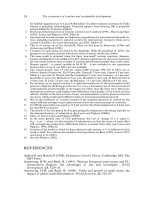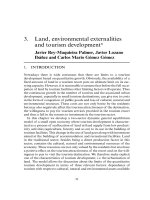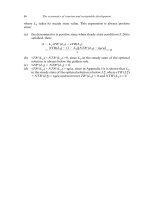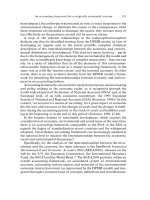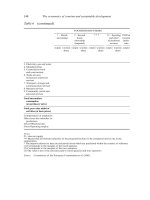THE ECONOMICS OF MONEY,BANKING, AND FINANCIAL MARKETS 390
Bạn đang xem bản rút gọn của tài liệu. Xem và tải ngay bản đầy đủ của tài liệu tại đây (39.46 KB, 1 trang )
358
PA R T I V
The Management of Financial Institutions
In two months, when her customer receives the 10 million euros, the forward
contract ensures that it is exchanged for dollars at an exchange rate of $1.40 per
euro, thus yielding $14 million. No matter what happens to future exchange rates,
Frivolous Luxuries will be guaranteed $14 million for the goods it sold in Germany.
Mona calls up her friend Sam to let him know that his company is now protected
from any foreign exchange movements, and he thanks her for her help.
Hedging
Foreign
Exchange Risk
with Futures
Contracts
As an alternative, Mona could have used the currency futures market to hedge the
foreign exchange risk. In this case, she would see that the Chicago Mercantile
Exchange has a euro contract with a contract amount of 125 000 euros and a price
of $1.40 per euro. To do the hedge, Mona must sell euros as with the forward contract, to the tune of $14 million of the March futures. How many of the Chicago
Mercantile Exchange March euro contracts must Mona sell in order to hedge the
10 million euro payment due in March?
Using Equation 1 with
VA + 10 million euros
VC + 125 000 euros
we have
NC + 10 million/125 000 + 80
Thus, Mona can hedge the 10 million euros by selling 80 of the CME euro contracts. Given the $1.40 per euro price, the sale of the contract yields 80 * 125 000
euros + $14 million. The futures hedge thus again enables her to lock in the
exchange rate for Frivolous Luxuries so that it gets its payment of $14 million.
One advantage of using the futures market is that the contract size of 125 000
euros, worth $175 000, is quite a bit smaller than the minimum size of a forward
contract, which is usually $1 million or more. However, in this case, the bank
manager is making a large enough transaction that she can use either the forward
or the futures market. Her choice depends on whether the transaction costs are
lower in one market than in the other. If the First Bank is active in the forward
market, that market would probably have the lower transaction costs, but if First
Bank rarely deals in foreign exchange forward contracts, the bank manager may
do better by sticking with the futures market.
STOC K I N DE X F U TU RE S
As we have seen, interest rate futures markets can be useful in hedging interestrate risk. However, financial institution managers, particularly those who manage
mutual funds, pension funds, and insurance companies, also worry about stock
market risk, the risk that occurs because stock prices fluctuate. Stock index
futures were developed in 1982 to meet the need to manage stock market risk, and
they have become among the most widely traded of all futures contracts. The
futures trading in stock price indexes is now controversial (see the FYI box,
Program Trading and Portfolio Insurance: Were They to Blame for the Stock
Market Crash of 1987?) because critics assert that it has led to substantial increases
in market volatility, especially in such episodes as 1987 s stock market crash.





